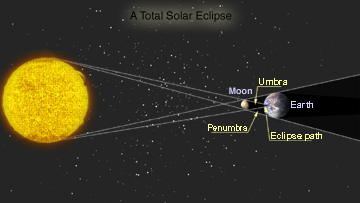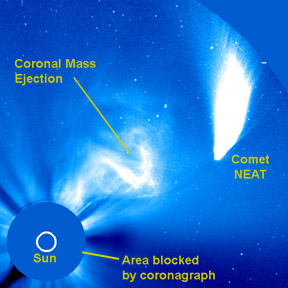Comet NEAT as seen by SOHO on 18 February 2003.
Click on image for full size
Image courtesy NASA
Comet NEAT passes Sun
News story originally written on February 20, 2003
The comet shown in this picture is really neat!
It is so neat that scientists named it Comet NEAT! Actually, this comet was discovered by NASA's
Near Earth Asteroid Tracking (NEAT) program, so that is the real reason it is called Comet NEAT.
This time NEAT found a comet instead of an asteroid.
This picture was taken by a spacecraft called SOHO.
When the SOHO spacecraft took this picture, we couldn’t see Comet NEAT
from Earth because the comet was too close to the Sun.
SOHO has a special instrument called a coronagraph which blocks the brightest light from the Sun.
A coronagraph is a lot like an eclipse
in the way it blocks the Sun's light.
Comets are made mostly of ice. When a comet gets near the Sun, the heat from the Sun makes some of the ice melt.
Scientists like to study comets that are close to the Sun to see how the comets change as they melt.
This picture also shows a Coronal Mass Ejection (CME).
A CME is a huge explosion on the Sun.
Scientists want to learn what a big explosion does to a comet when it is this close to the Sun.
You might also be interested in:

An eclipse of the Sun occurs when the Earth passes through the moon's shadow. A total eclipse of the Sun takes place when the Moon is directly between the Sun and the Earth. When a total eclipse does
...more
It was another exciting and frustrating year for the space science program. It seemed that every step forward led to one backwards. Either way, NASA led the way to a great century of discovery. Unfortunately,
...more
The Space Shuttle Discovery lifted off from Kennedy Space Center on October 29th at 2:19 p.m. EST. The sky was clear and the weather was great. This was the America's 123rd manned space mission. A huge
...more
Scientists found a satellite orbiting the asteroid, Eugenia. This is the second one ever! A special telescope allows scientists to look through Earth's atmosphere. The first satellite found was Dactyl.
...more
The United States wants Russia to put the service module in orbit! The module is part of the International Space Station. It was supposed to be in space over 2 years ago. Russia just sent supplies to the
...more
A coronal mass ejection (CME) happened on the Sun last month. The material that was thrown out from this explosion passed the ACE spacecraft. ACE measured some exciting things as the CME material passed
...more
Trees and plants are a very important part of this Earth. Trees and plants are nature's air conditioning because they help keep our Earth cool. On a summer day, walking bare-foot on the sidewalk burns,
...more















